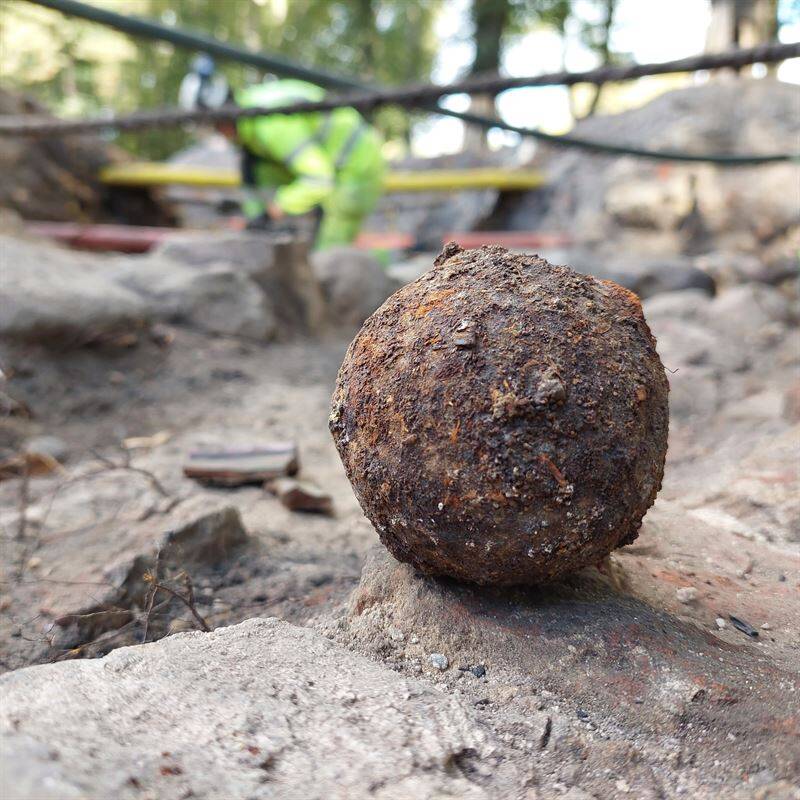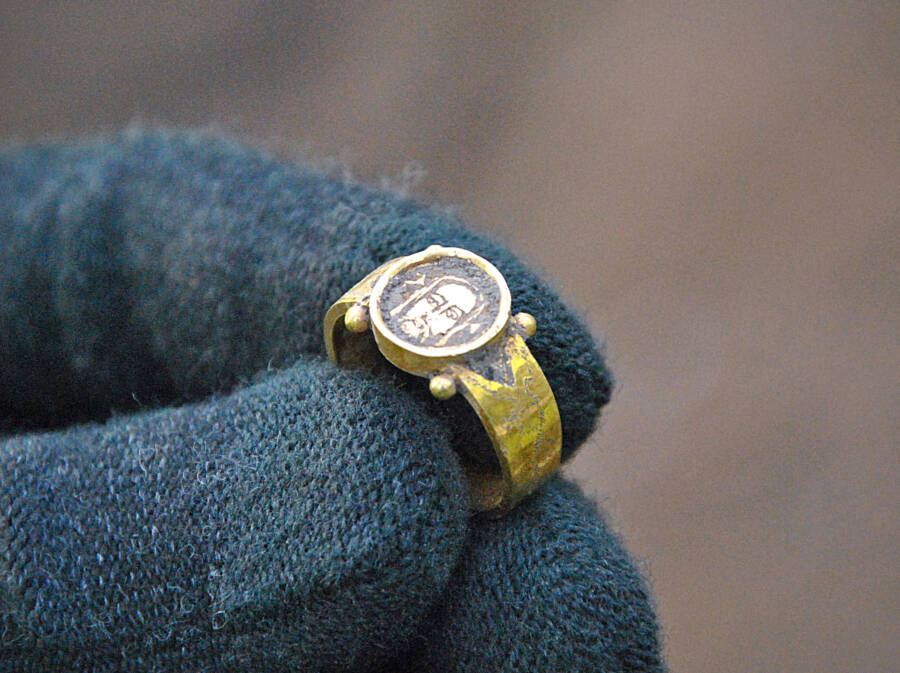Ongoing archaeological excavations in Kalmar, Sweden have revealed a wealth of objects, including a stunning gold ring that was likely lost 500 years ago.

Frida Albinsson/Arkeologerna/SHMThe 500-year-old gold ring engraved with the face of Jesus Christ.
Swedish archaeologists recently uncovered an ancient treasure trove, including a gold ring that was lost more than 500 years ago.
Archaeologists from Sweden’s National Historical Museums have been carrying out ongoing excavations in central Kalmar, unearthing the remains of hundreds of buildings, cellars, streets, latrines, and miscellaneous objects dating from 1250 to 1650. During the course of these excavations, they have discovered 50 medieval plots, 10 streets, and parts of the old city wall, as well as more than 30,000 objects.
Discoveries ‘Beyond All Expectations’ In The City Of Kalmar
“We have been able to lift the lid on the city’s Middle Ages and have had the opportunity to study how people lived, what they ate and drank and how this changed over time,” said archaeologist Magnus Stibéus in a translated statement by The Archaeologists, part of Sweden’s National Historical Museums. “Archaeology becomes like a peephole into medieval history that allows us to learn more about how life was several hundred years ago.”
Among the more fascinating finds was a gold ring that features an engraved image of Jesus Christ dating back to the early 15th century. Given how small the ring is, archaeologists believe it was likely worn by a woman.
“Of course, it’s great fun to find something like that,” Stibéus said, noting that the ring was “in almost new condition.” He theorized, “Probably someone was unlucky and lost the ring 500 years ago.”
Alongside the ring, archaeologists also discovered an “alsengem,” a small glass stone believed to have been used as a pilgrim amulet. Alsengems get their name from the Danish island of Als, where they were first discovered.

Frida Albinsson/Arkeologerna/SHMThe broken fragment of the alsengem along with a reconstruction of what it may have looked like whole.
The Kalmar alsengem dates back to the 13th or 14th century and features three carved figures. Stibéus said the alsengem is “broken and may have been thrown away.”
Archaeologists also unearthed the remains of a rune stone, which they believe may have come from a burial mound in a nearby cemetery from the 12th century, and a brick with a cat’s paw print imprinted in it.
Many of these finds harken back to the Kalmar War, a conflict fought between Denmark-Norway and Sweden between 1611 and 1613.
Remnants Of The Kalmar War
The war was named after the Kalmar Sound, a strategic body of water that separates Denmark from Sweden, and it was primarily sparked by disputes over territory and control of certain trade routes in the Baltic Sea. The waterway was an area of significant economic importance due to its role in the lucrative trade of goods such as timber, tar, and fur.

Magnus Stibéus/Arkeologerna/SHMAn ancient cannonball dating back to the Kalmar War.
The conflict was rooted in long-standing rivalries and territorial disputes between the Scandinavian kingdoms, which had been exacerbated by the dissolution of the Kalmar Union in 1523.
The Union had previously brought the kingdoms under a single monarch, but its end led to heightened competition and conflict. King Christian IV of Denmark-Norway sought to assert dominance over the Baltic region and was particularly interested in reclaiming territories lost to Sweden.
Meanwhile, King Charles IX of Sweden aimed to protect and expand his nation’s interests and territory in the region.
The Kalmar War concluded with the Treaty of Knäred in 1613. The treaty was somewhat inconclusive in terms of territorial gains. Sweden had to pay a hefty ransom for two important fortresses that had been captured by Denmark-Norway during the war. Additionally, Sweden agreed to grant Denmark-Norway control over certain trade routes in exchange for lifting the devastating blockades.
“The investigations show that virtually all farms were burned in connection with the Danes’ attack on the city in the summer of 1611,” Stibéus said. “This is visible above all through fire horizons and razed buildings. We have also found a large number of projectiles, such as cannonballs, musket balls and pistol bullets, but also swords.”

Frida Albinsson/Arkeologerna/SHMThe image of Jesus Christ on the ancient gold ring.
Stibéus referred to the numerous discoveries as a “historical archive that holds enormous amounts of information and stories about the political and economic ambitions, everyday life, and living conditions of previous generations.”
Being able to investigate such large parts of ancient cities all at once is something of a rarity, but in this instance, it proved to be incredibly valuable.
“We get an insight into large parts of the medieval city and encounter traces of the social and economic existence of different groups: traders, craftsmen, civil servants, church people, poor and rich,” Stibéus said.
After reading about the gold ring discovered in Sweden, learn more about King Adolf Frederick, the Swedish royal who ate himself to death. Or, read about the Vasa, the epic 17th-century Swedish ship that sank in just 20 minutes.





